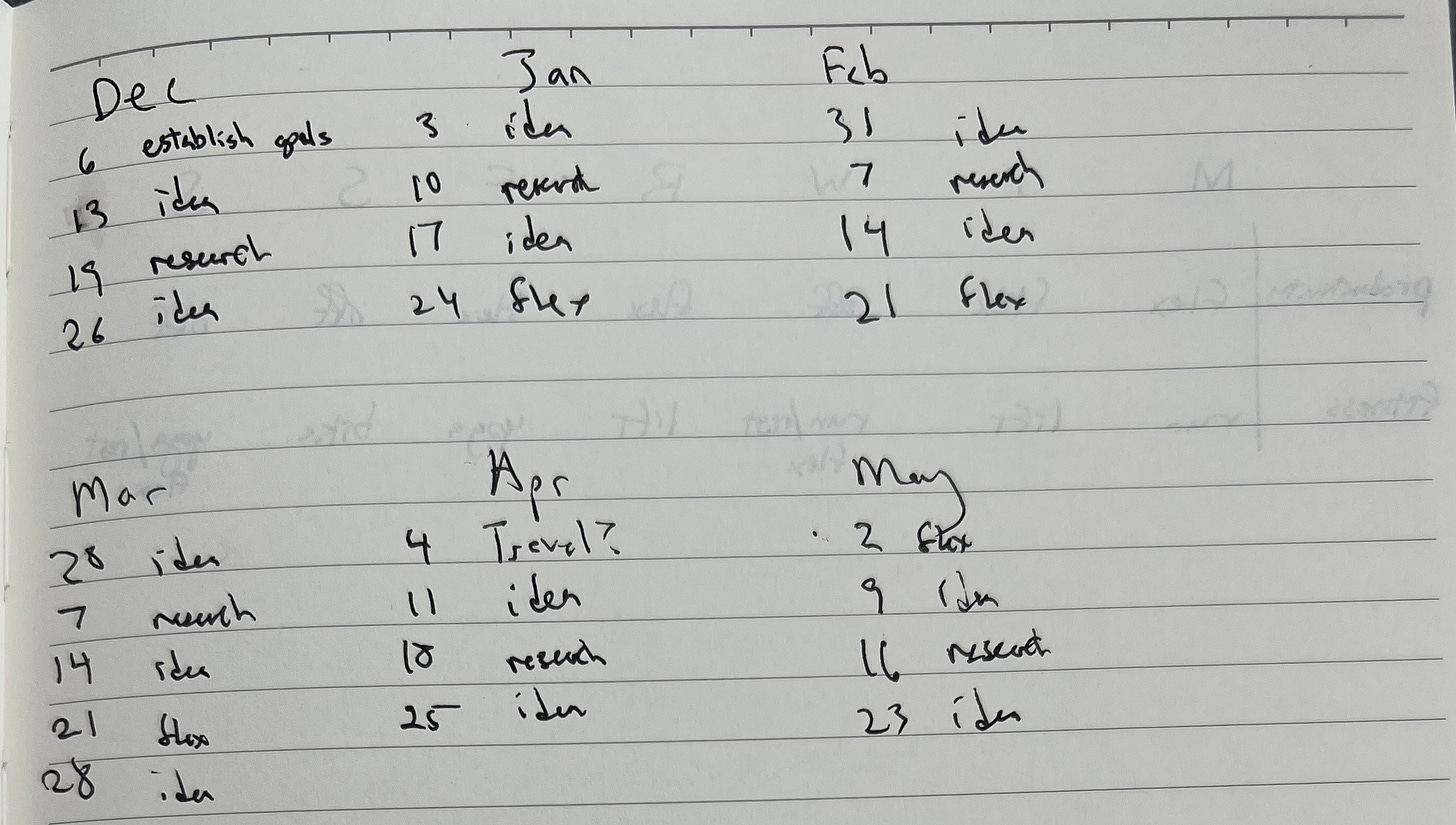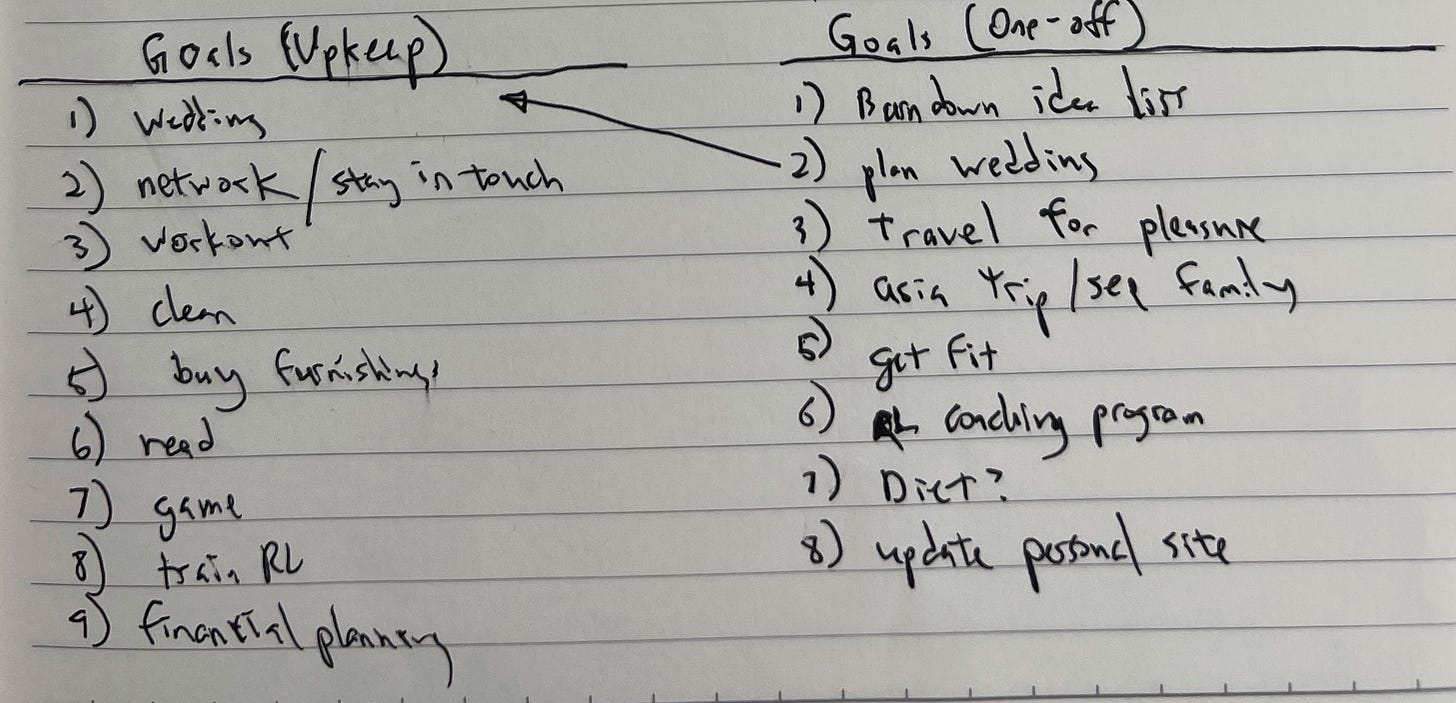It’s been two weeks since I left Samsara, and I think it’s about time to get the ball rolling. Things I’ll talk about: what this newsletter is, what my goals are, and a revisit on exploration vs exploitation.
About This Newsletter
If you’re getting this, you either want to follow along with my exploration, or I’ve been sending you Holiday Update emails for the past couple years. In case you missed it, I left my job after 4 years and am now taking 6 months to burn down a long list of ideas. I’m very lucky to have a bit of financial flexibility now thanks to the IPO, and will hopefully utilize this time well!
This newsletter is meant to be a catalogue of my idea exploration. Things I write here are not meant to be super polished - they will mostly be napkin math and random findings. I would very much be interested in discussing anything that comes up - let me know what piques your interest!
In terms of cadence, my hope is to write an update every 2 weeks for this period of my life. That said, things change rapidly, so who knows 🤷♂️.
Finally, if you’re interested in unfiltered or shorter-form content, you can always check out Instagram or Twitter.
Frameworks for Unstructured Time
It’s been interesting to introspect in the last 2 weeks. I felt mostly incapable of meaningfully tapping into my usual curiosity. I’ll attribute this to needing some time to rest after the hard burn closing out my responsibilities at Samsara. I think monitoring this over time will be an extremely useful feedback loop.
One thing I did do was create some structure for my 6 months. As my old co-workers will know, I live and breathe structure and process 😅. I also read a book on time management called Four Thousand Weeks, which turned out to secretly be a book on nihilism and the beauty of meaninglessness. Little did the author know, I’m already a nihilist 😆.
Anyway, my approach to this period of massive flexibility is to set conservative limits on the amount I expect to work. During my medical leave, I found that my main issue was over-working; there was no affordance for my mind to stop focusing. When I returned to my “9 to 5”, the cathartic release once the clock hit 5pm was fascinating.
So, here’s what I’ve got so far. If you’ve done this kind of thing before and have tips, I’d really love to hear what did and didn’t work for you. Let me know!
Weekly Structure
I’d like to work four days out of every week, but exact days can “flex”. I’ll re-evaluate every morning whether it’ll be a productive day or an off day. Also, I figure exercise will pretty much be my only structured social interaction, so I’ll lean into that a bit more aggressively.
6 Month View
Given a list of about 20 ideas, and 1.5 weeks per idea, that works out to around 6 months of time. I want to alternate weeks of researching new topics (exploration) and idea analysis (exploitation), with one week flexible per month.
Overall, it’d probably be smart for me to start off more heavily in exploration, and by the end of the time hopefully be spending most of my time diving deeper into a small number of ideas.
Top-level Goals
And of course, what time structure would be worth anything without some OKRs? Just kidding, I don’t want to write actual OKRs. But, I do want to set expectations for what I’d be sad not to have achieved at the end of this time.
On the ideas side, my hope is that one is interesting enough to start a company around. Realistically though, you never know. It’s also possible that 6 months isn’t enough time - I’ll have to revisit at that time.
On the personal side: travel twice, do a coaching program for Rocket League, get married.
Revisiting Exploration vs Exploitation
I only just started my first deep dive, so instead of writing about that, I’m going to revisit an old one. This one is important for framing my approach moving forward. If you’re new to my deep dives, this is pretty much what you can expect to find moving forward.
In computational theory, there’s a common optimization problem for a maximizing utility over a pool of resources. We can either try to find more resources (exploration) or optimize the use of the resources we already have (exploitation).
If you take this idea and zoom all the way out, here’s an interesting question to consider: “Should humanity as a whole focus on exploration or exploitation?” Of course, this is a false dichotomy because we will always be doing both. But, understanding the macro view is helpful to inform what the highest leverage way of using our time is.
From my perspective, there are two interesting pools of resources to analyze for humanity: knowledge and materials. Today, I’ll focus on knowledge.
So, does humanity have enough knowledge to create tremendous value right now, or should we be looking for new knowledge? To answer this question, we have to understand how knowledge becomes value.
How Knowledge Becomes Value
I’ve been reading a lot about the history of technology1. Something that’s consistent throughout many of these stories is this: they’re able to ride the wave of a breakthrough in basic research. The breakthrough creates a problem rich environment, allowing people to pick and cross virtually anything with the breakthrough and create something of value. A prime example: Computers x Movies → Pixar, $10B company.
The overarching pattern is: Basic Research Breakthrough → Practical Application → Business Success. More examples:
Discovery of Electricity → Centralized Power Generation → Edison Electric Monopoly
Voice over Wire → Telephone Networks → Bell System Monopoly
Transistor → Personal Computer → Microsoft, Apple
Information Theory → The Internet → We’ll come back to this
Here’s an interesting observation: each basic research breakthrough has a fixed amount of value that can be created in the form of companies. Restated, this would be the cumulative TAM of all companies created based on the breakthrough. The distribution curve of valuations is consistent across breakthroughs, but varies in magnitude.
Here’s a oversimplified model: every breakthrough has a fixed set of companies that can emerge:
~5 companies of $1T value - impacting all of humanity
~50 companies of $100B value - impacting an entire sector
~500 companies of $10B value - impacting a big niche
~5000 companies of $1B value - impacting a small niche
Taking the example of the internet as the basic research breakthrough:
Worldwide impact, all of humanity - $1T value, ~5 companies
Google
Facebook
Amazon
Entire Sector, all of commerce - $100B, ~50 companies
Salesforce
Stripe
Square
Shopify
Big Niche - $10B, ~500 companies
Samsara
Pixar
Flexport
Opendoor
Small Niche - $1B, ~5000 companies
2017 Samsara (Trucking Compliance)
Pagerduty
Classpass
Lattice
Carta
This curve gets really obvious zooming out. Here’s my plot of valuations of the top 1000 unicorns, log scale:
Applying the Framework
To answer the exploration vs exploitation question, we could follow this process:
Pick an existing basic research breakthrough
Curve fit the existing companies executing on that breakthrough to the expected distribution
Identify gaps in that curve
Repeat for every breakthrough
Cumulatively sum all the gaps
However, I’m not going into that level of rigor right now. The most personally relevant question to me is this: “Is Tech as we know it is played out?” Depending on which breakthrough you define as “Tech”, maybe or maybe not.
If we’re talking about SaaS at the time when I graduated in 2014, probably. Lots of people in the industry have said this, including Chris Dixon in 2016. I don’t know this for sure, but it certainly feels like SaaS has squeezed dry the all-humanity bucket, the all-commerce bucket, and much of the big niche bucket. There are probably more opportunities in the small niche bucket.
But, if you expand “Tech” to constantly fold in new research breakthroughs as they happen, maybe the wave can continue for the foreseeable future? E.G. Square becoming Block, Facebook becoming Meta.
It’s interesting that today’s world doesn’t have major corporate research institutions pushing forward basic research like in the past (e.g. Xerox Parc, Bell Labs). Maybe the closest examples today are places like Google X, Microsoft Research, or OpenAI, but they seem a bit more short-term oriented. Perhaps the future will return to that kind of environment, investing in long term research institutions?
A Different Approach: PHD Population Statistics
Anecdotally, I remember at MIT that almost all people in CS at the time opted to go into industry, as the general feeling was that startup opportunities abounded. What if we look at PHD vs Industry aggregate decision making over time?
For the most part, PHD participation has gone up and to the right over time.
But, if you scale the numbers by the total number of college attendees, you see a depression in PHD participation at around the time of the dot com boom.
Unclear if correlation or causation, or maybe if completely unrelated (economic downturns play a nontrivial role here I bet), but interesting nonetheless. Today, the participation rate in PHDs is the highest it has ever been. Does that imply that we’re collectively deciding that exploration is more valuable than exploitation?
My Thoughts Moving Forward
I’ll cast my vote for exploitation. In my opinion, there’s sufficient value potential just continuing to cross new research breakthroughs with Tech-as-we-know-it. Also, as a committed industry-insider, I’m not about to pivot my life into deep research. I guess I’m a little biased 😛
Anyway, since nobody can see the future, nobody actually knows for certain which “breakthroughs” are winners vs losers. Here’s an interesting path forward: take all the current potential breakthroughs and cross them with the TAM buckets framework and see what comes out of that.
Some possible topics that I could dive into in the coming months:
Deep Learning
Defi
3D Printing
VR
Bionics / human augmentation
CRISPR
Quantum Computing
Here’s VR as a straw man:
$1T: Internet for VR
$100B: VR/AR for military combat
$10B: VR/AR cinematic storytelling
$1B: VR for trauma therapy
That said, the TAM framework isn’t a fair categorization of most companies, because it assumes their positioning in the market is static. In reality, companies pivot all the time to reposition towards different macro waves. Prime example: Segment.io starting as an analytics tool snippet organizer and evolving to be a data lake company. There’s a strong argument to be made for “just build some stuff and you’ll be able to react appropriately no matter what happens”.
Next Up
If you got this far, thanks for reading 🙏 I’d love to hear your thoughts. If you already saw this on my Instagram, whoops, I’m still working on my first actual deep dive. Next time, I’d like to cover these topics:
Exploration vs Exploitation: Materials
Moore’s Law and AR Contact Lenses
My recommendations for books on the history of technology:
Three Body Problem (surprisingly relevant)









i love giving you write access to my brain
Loved this first read. I'm curious if the exploration vs exploitation argument could be sector specific, ie I would question whether we are in exploration or exploitation territory for combating climate change -- to me this seems more exploration oriented, yet it's exciting to see VCs invest more heavily in companies (exploitation). In any case, I am realizing that I should have used my time off more wisely / thoughtfully, and I respect your approach to planning your OKRs and even weekly focuses. Keep 'em coming.